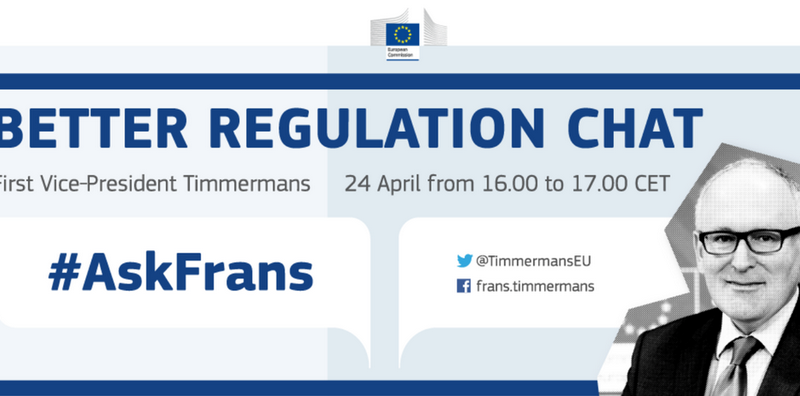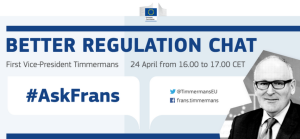Commission Twitter-chats: interactivity-washing

 At 1600 CET today, First Vice President of the European Commission Frans Timmermans will do an online chat on Twitter and Facebook* – tag is #AskFrans. Transport Commissioner Violeta Bulc will do the same on Monday 27th April at 1400 CET – tag there is #ITS2015chat.
At 1600 CET today, First Vice President of the European Commission Frans Timmermans will do an online chat on Twitter and Facebook* – tag is #AskFrans. Transport Commissioner Violeta Bulc will do the same on Monday 27th April at 1400 CET – tag there is #ITS2015chat.
Oooooh, look, little users of social media! Come and ‘chat’ to the Commissioners for an hour! Look at how interactive I am!
So the Commissioners can thereafter resort to form and then broadcast out pictures of them shaking hands with people, or retweet quotes of theirs spoken at events, for the rest of the time.
Put it another way: Twitter chats are convenient interactivity-washing – they demonstrate some engagement, but strictly on the Commissioner’s own terms, and at a time they themselves set. In the case of Bulc and Timmermans it therefore means that @-replying them at any other time is like tweeting into a black hole. Not only is next to impossible to get a reply from either of them, but it is also a perfectly reasonable assumption that none of the everyday tweets written first person in their name are actually written by them. If you doubt it, look for any sort of normal Twitter interaction here from Timmermans or here from Bulc – you won’t find any. Malmström and Georgieva are the exceptions in the Commission, not the rule.
That doesn’t mean these chats are useless – they are better than nothing. But they are far from being the solution for good online communications from Commissioners!
* – yes, I am aware that Timmermans is more of a Facebook fan than a Twitter person, but Twitter is the social network for EU policy discussion, and all Commissioners are present on it.
@Dana – you’re right that it should not be an either-or, but with most of the Commission it IS that. A Twitter chat is all you get when it comes to interaction!
For me, social media chats complement the regular engagement on social media. [It is not an “either-or” situation as you seem to imply with “interactivity-washing”] They become “events” and can raise awareness on a topic and stimulate a conversation with any interested party. They also demonstrate that the Commissioners are ready to respond to citizens’ questions on what the European Commission is doing and why.
They are an opportunity for citizens to discuss EC priority projects directly with the politicians. They are also an opportunity for the politicians to get feed-back.
I think it is more a Twitter QnA rather than a real chat. Like you said, it is on their own terms and it is to show some minimum level of interaction with the public. On the other hand, the public is not at all interested in what he is doing – except what he did at the national level, which is why he was trolled for MH17 during the chat. The only people who are interested in the chat, are EU bubble people. Mostly the people who cannot get to speak to him in person. I wish they’d change the format though – to make it into a real chat rather than a QnA, because that will get people talking about issues rather than throwing questions at him.
@Margarethe – this blog entry deals with that issue!
Are all Commissioners on Twitter? And to what extent do you think those accounts are managed by some social media savvy strategist vs the actual Commissioners themselves?